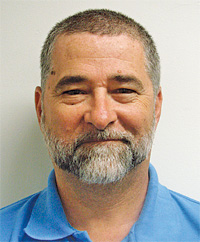Five Minutes With Audio & Video Home
fiveminuteswith
The Manager's Role in LEED Certification with Curt Stainbrook
Curt Stainbrook, mechanical systems manager with Macalester College facilities services in St. Paul, Minn., discusses the HVAC and building-automation system technologies in one LEED-certified facility

Curt Stainbrook
Mechanical Systems Manager
Macalester College
Facilities Services
St. Paul, Minn.
What was your role in helping the college achieve LEED-Platinum certification for Markim Hall?
I attended design-review meetings with the architects, engineers, and the construction team to make sure we could maintain the building without affecting the Leadership in Energy and Environmental Design (LEED) certification process.
I also did some research on the new types of technology being proposed to familiarize myself with it and to take a critical look at their viability. During construction, our maintenance engineers kept an eye on how the systems were installed and how they were being programmed to accommodate both certification and system operation.
Can you discuss the HVAC technology specified for Markim Hall, including the heating and chilled sails?
The HVAC systems consist of a make-up air unit and a dual-temperature water-circulation system. The make-up air unit is a 100 percent outside-air fan fitted with an enthalpy wheel that is used to recover some of the energy used to condition the air.
An enthalpy wheel exchanges heat and humidity from one air-stream into another. Rather than discard used building air, an enthalpy wheel salvages useful energy and transfers it to incoming, fresh air. This saves energy by reducing the need for cooling in the summer and heating in the winter.
The dual-temperature system supplies either hot or cold water, depending on the season, through copper pipes directly attached to a flat aluminum panel, or “sail,” mounted below the ceiling. As air circulates around these sails, the temperature differential between the panel and the sail cools or warms the air to control the temperature in the space. There is also in-floor tubing that circulates the same water and provides heating or cooling in the main lobby and one of the large conference rooms.
One of the obvious benefits of these technologies is energy savings. Another benefit is how quiet these systems are. The fan unit only uses about 3,000 cubic feet per minute (cfm), and the rest of the systems are just circulating water through pipes, so there is very little noise associated with their operation.
Maintenance is similar to any water-circulation system, with the exception of the enthalpy wheel, which eventually will require cleaning. However, with good air filtration, this would be no more frequent than cleaning a coil.
What role did commissioning the facility play in helping train maintenance and engineering staff on the technologies within Markim Hall?
The commissioning specified training in-house staff as a requirement, and we received it from both the mechanical and controls contractors. We request training in the specifications for large projects, so it would have occurred with or without commissioning. However, it most likely saved time by having corrected discrepancies before the training sessions instead of during the sessions.
Can you talk about Markim Hall's building-automation system and its impact on streamlining maintenance and engineering activities, as well as achieving tighter control on the building environment?
The building-automation system is an extension of the system that operates the HVAC system for all but one of the buildings on campus. Our maintenance staff worked with the manufacturer technicians to load the set points we normally use to control the environment.
In Markim Hall, we have a valve at every sail to control either individually or by floor. There are dew-point sensors on each floor to make sure there is no condensation on the sails when in summer – chilled-water – mode. There also are pressure-differential sensors to indicate filter-change intervals, variable-speed drives on the pumps, carbon-dioxide sensors for air-quality monitoring, and enthalpy controls for optimizing the enthalpy wheel.
These all work in concert with a very tight and well-insulated building envelope to conserve energy while providing a comfortable environment.
What lessons did you learn with the Markim Hall project that you can apply to future LEED projects or other green initiatives?
You have to pay a lot of attention to the building envelope. A well-engineered and constructed envelope will more than pay off in the long run. It eliminates weather-related temperature and humidity swings, making the environment inside much easier to control.
You also have to be willing to try some of the untested technology that is out there and be ready to re-engineer some of it, if necessary. We had 28 condensation sensors that were designed to close a valve if they detected moisture, and they just didn’t have the reliability we were looking for. So, our mechanical contractor and the manufacturer technicians redesigned the system, eliminated the individual sensors, and used dew-point calculations from temperature and humidity sensors to prevent condensation on the sails.
Find more on this topic:
leed, usgbc, maintenance and operations hvac, chilled water, iaq, enthalpy wheel
posted: 7/8/2010








